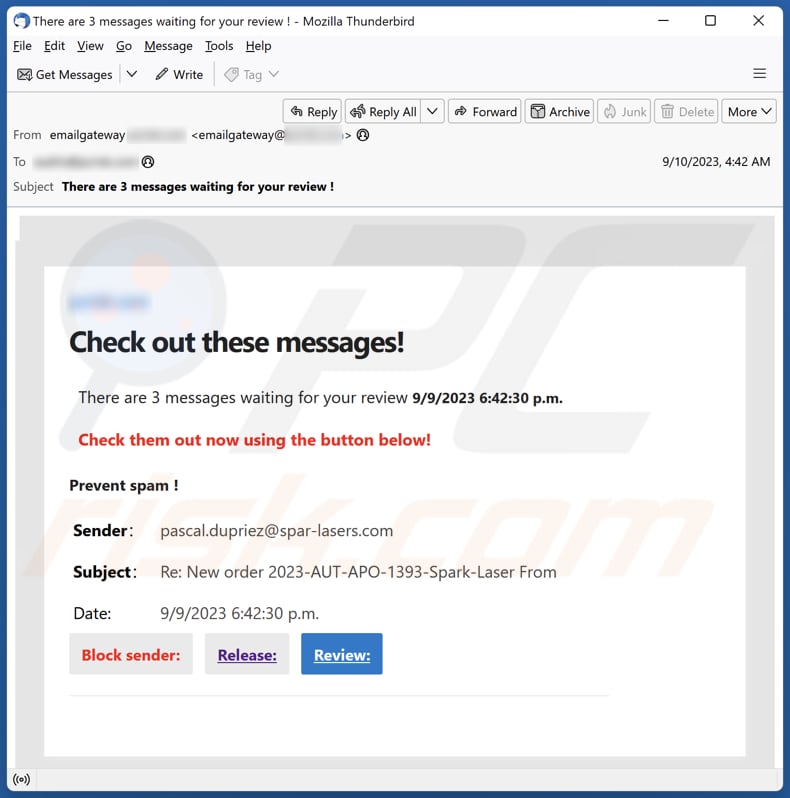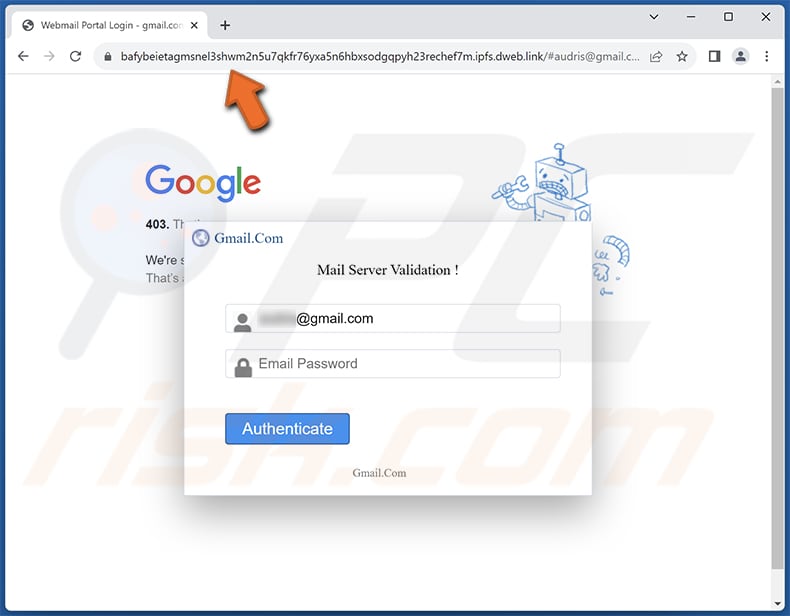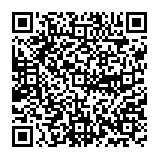How to spot fraudulent letters like "Check Out These Messages!"
![]() Written by Tomas Meskauskas on
Written by Tomas Meskauskas on
What is "Check Out These Messages!"?
After conducting a thorough review, our team has established that the intent behind this email is to trick recipients into disclosing their personal information. These emails are classified as phishing attempts, and in this specific situation, the scammers masquerade as an email service provider with the goal of duping recipients into exposing sensitive data on a phishing page.

More about the "Check Out These Messages!" scam email
The phishing email has a subject line indicating that there are three messages awaiting review. It encourages the recipient to click on a button to view these messages. However, upon closer examination, it becomes clear that this email is a phishing attempt.
This letter aims to deceive the recipient into clicking on the provided link/button labelled "Release" or "Review", which leads to a fraudulent website designed to steal personal information (login credentials).
The phishing page, which is promoted through this email, cleverly imitates the appearance of a legitimate webpage based on the recipient's email address. Specifically, if the recipient uses Gmail as their email service provider, the fraudulent page pretends to be the Gmail sign-in page. Scammers use this site to steal email account login credentials.
With access to email accounts, crooks can obtain personal information, such as full names, addresses, and contact details, to commit identity theft or impersonate the victim for fraudulent activities.
Also, scammers can use the compromised email account to send phishing emails and spam messages to the victim's contacts, potentially tricking them into revealing sensitive information or infecting their devices with malware.
Furthermore, stolen email credentials may provide access to financial accounts linked to the email, allowing scammers to conduct unauthorized transactions, change account details, or manipulate financial information for fraudulent purposes.
Email accounts are often linked to various online accounts, including social media, banking, and shopping platforms. Scammers can use the victim's email to initiate password reset requests, gaining control over these accounts. Also, they may try to access other accounts using the same login credentials.
| Name | Check Out These Messages! Email Scam |
| Threat Type | Phishing, Scam, Social Engineering, Fraud |
| Fake Claim | Multiple emails are awaiting review |
| Disguise | Letter from an email service provider |
| Symptoms | Unauthorized online purchases, changed online account passwords, identity theft, illegal access of the computer. |
| Distribution methods | Deceptive emails, rogue online pop-up ads, search engine poisoning techniques, misspelled domains. |
| Damage | Loss of sensitive private information, monetary loss, identity theft. |
| Malware Removal (Windows) | To eliminate possible malware infections, scan your computer with legitimate antivirus software. Our security researchers recommend using Combo Cleaner. |
Similar scam emails in general
Phishing emails constitute deceitful messages dispatched by cybercriminals with the aim of deceiving recipients into disclosing sensitive personal information like login credentials or financial details. Frequently, these emails present a facade of authenticity and include counterfeit links or attachments that direct individuals to harmful websites or initiate malware downloads.
More examples of fraudulent emails are "Donation From Coca-Cola", "Repair Response", and "Contract For Invoice".
How do spam campaigns infect computers?
Users may unwittingly jeopardize the security of their computers by engaging with attachments or hyperlinks in fraudulent emails. Such deceptive emails frequently include malicious attachments, such as PDFs, Microsoft Office documents (e.g., Word or Excel), JavaScript files, executable files marked with .exe extensions, ISO files, or compressed archive files such as ZIP or RAR.
Upon opening such attachments or following the included hyperlinks, users may inadvertently trigger the downloading and activation of harmful software. Cybercriminals often resort to deceptive methods within emails to convince users to engage in these hazardous activities.
How to avoid installation of malware?
Exercise caution when encountering emails from unfamiliar or dubious origins, particularly if they contain unexpected attachments or hyperlinks. Obtain software and files exclusively from reputable sources, such as official websites or authorized stores. Steer clear of potentially hazardous platforms, including unofficial app marketplaces, peer-to-peer (P2P) networks, and similar platforms.
Set up trustworthy antivirus or anti-malware software on your computer. Ensure that your operating system, software applications, and antivirus program have the latest updates. Be vigilant when interacting with advertisements, pop-up notifications, or links on websites that appear dubious.
If you have already opened malicious attachments, we recommend running a scan with Combo Cleaner Antivirus for Windows to automatically eliminate infiltrated malware.
Text presented in the "Check Out These Messages!" email letter:
Subject: There are 3 messages waiting for your review !
-
Check out these messages!There are 3 messages waiting for your review 9/9/2023 6:42:30 p.m.
Check them out now using the button below!Prevent spam !
Sender: pascal.dupriez@spar-lasers.com
Subject: Re: New order 2023-AUT-APO-1393-Spark-Laser From
Date: 9/9/2023 6:42:30 p.m.
Block sender: Release: Review:
Phishing website promoted via this scam email:

Instant automatic malware removal:
Manual threat removal might be a lengthy and complicated process that requires advanced IT skills. Combo Cleaner is a professional automatic malware removal tool that is recommended to get rid of malware. Download it by clicking the button below:
▼ DOWNLOAD Combo Cleaner
By downloading any software listed on this website you agree to our Privacy Policy and Terms of Use. To use full-featured product, you have to purchase a license for Combo Cleaner. 7 days free trial available. Combo Cleaner is owned and operated by Rcs Lt, the parent company of PCRisk.com read more.
Quick menu:
- What is Check Out These Messages! phishing campaign?
- Types of malicious emails.
- How to spot a malicious email?
- What to do if you fell for an email scam?
Types of malicious emails:
![]() Phishing Emails
Phishing Emails
Most commonly, cybercriminals use deceptive emails to trick Internet users into giving away their sensitive private information, for example, login information for various online services, email accounts, or online banking information.
Such attacks are called phishing. In a phishing attack, cybercriminals usually send an email message with some popular service logo (for example, Microsoft, DHL, Amazon, Netflix), create urgency (wrong shipping address, expired password, etc.), and place a link which they hope their potential victims will click on.
After clicking the link presented in such email message, victims are redirected to a fake website that looks identical or extremely similar to the original one. Victims are then asked to enter their password, credit card details, or some other information that gets stolen by cybercriminals.
![]() Emails with Malicious Attachments
Emails with Malicious Attachments
Another popular attack vector is email spam with malicious attachments that infect users' computers with malware. Malicious attachments usually carry trojans that are capable of stealing passwords, banking information, and other sensitive information.
In such attacks, cybercriminals' main goal is to trick their potential victims into opening an infected email attachment. To achieve this goal, email messages usually talk about recently received invoices, faxes, or voice messages.
If a potential victim falls for the lure and opens the attachment, their computers get infected, and cybercriminals can collect a lot of sensitive information.
While it's a more complicated method to steal personal information (spam filters and antivirus programs usually detect such attempts), if successful, cybercriminals can get a much wider array of data and can collect information for a long period of time.
![]() Sextortion Emails
Sextortion Emails
This is a type of phishing. In this case, users receive an email claiming that a cybercriminal could access the webcam of the potential victim and has a video recording of one's masturbation.
To get rid of the video, victims are asked to pay a ransom (usually using Bitcoin or another cryptocurrency). Nevertheless, all of these claims are false - users who receive such emails should ignore and delete them.
How to spot a malicious email?
While cyber criminals try to make their lure emails look trustworthy, here are some things that you should look for when trying to spot a phishing email:
- Check the sender's ("from") email address: Hover your mouse over the "from" address and check if it's legitimate. For example, if you received an email from Microsoft, be sure to check if the email address is @microsoft.com and not something suspicious like @m1crosoft.com, @microsfot.com, @account-security-noreply.com, etc.
- Check for generic greetings: If the greeting in the email is "Dear user", "Dear @youremail.com", "Dear valued customer", this should raise suspiciousness. Most commonly, companies call you by your name. Lack of this information could signal a phishing attempt.
- Check the links in the email: Hover your mouse over the link presented in the email, if the link that appears seems suspicious, don't click it. For example, if you received an email from Microsoft and the link in the email shows that it will go to firebasestorage.googleapis.com/v0... you shouldn't trust it. It's best not to click any links in the emails but to visit the company website that sent you the email in the first place.
- Don't blindly trust email attachments: Most commonly, legitimate companies will ask you to log in to their website and to view any documents there; if you received an email with an attachment, it's a good idea to scan it with an antivirus application. Infected email attachments are a common attack vector used by cybercriminals.
To minimise the risk of opening phishing and malicious emails we recommend using Combo Cleaner Antivirus for Windows.
Example of a spam email:

What to do if you fell for an email scam?
- If you clicked on a link in a phishing email and entered your password - be sure to change your password as soon as possible. Usually, cybercriminals collect stolen credentials and then sell them to other groups that use them for malicious purposes. If you change your password in a timely manner, there's a chance that criminals won't have enough time to do any damage.
- If you entered your credit card information - contact your bank as soon as possible and explain the situation. There's a good chance that you will need to cancel your compromised credit card and get a new one.
- If you see any signs of identity theft - you should immediately contact the Federal Trade Commission. This institution will collect information about your situation and create a personal recovery plan.
- If you opened a malicious attachment - your computer is probably infected, you should scan it with a reputable antivirus application. For this purpose, we recommend using Combo Cleaner Antivirus for Windows.
- Help other Internet users - report phishing emails to Anti-Phishing Working Group, FBI’s Internet Crime Complaint Center, National Fraud Information Center and U.S. Department of Justice.
Frequently Asked Questions (FAQ)
Why did I receive this email?
Scammers disseminate the same messages to a large audience, hoping that someone will fall victim to their scams. These spam emails lack any form of personalization.
I have provided my personal information when tricked by this email, what should I do?
In the event that you have unintentionally revealed personal information, such as your email account login details, it is essential to act swiftly. Alter your passwords, maintain a vigilant watch over your accounts for any uncommon or suspicious actions, and promptly notify your email service provider (or relevant service) of the potential security breach.
I have downloaded and opened a file attached to an email, is my computer infected?
The level of risk varies depending on the file type. For instance, files with .exe extensions carry a higher risk, whereas infections through file types like MS Office documents only occur when users enable macro commands.
I have read the email but did not open the attachment, is my computer infected?
Simply opening an email is typically safe and does not present an immediate threat. The risk emerges when recipients engage with the email by clicking on embedded links or opening attached files.
Will Combo Cleaner remove malware infections that were present in email attachment?
Certainly, Combo Cleaner has the ability to detect and remove virtually all known malware. It is necessary to bear in mind that advanced malware typically hides deeply within the system. As a result, conducting a thorough system scan is imperative.


▼ Show Discussion